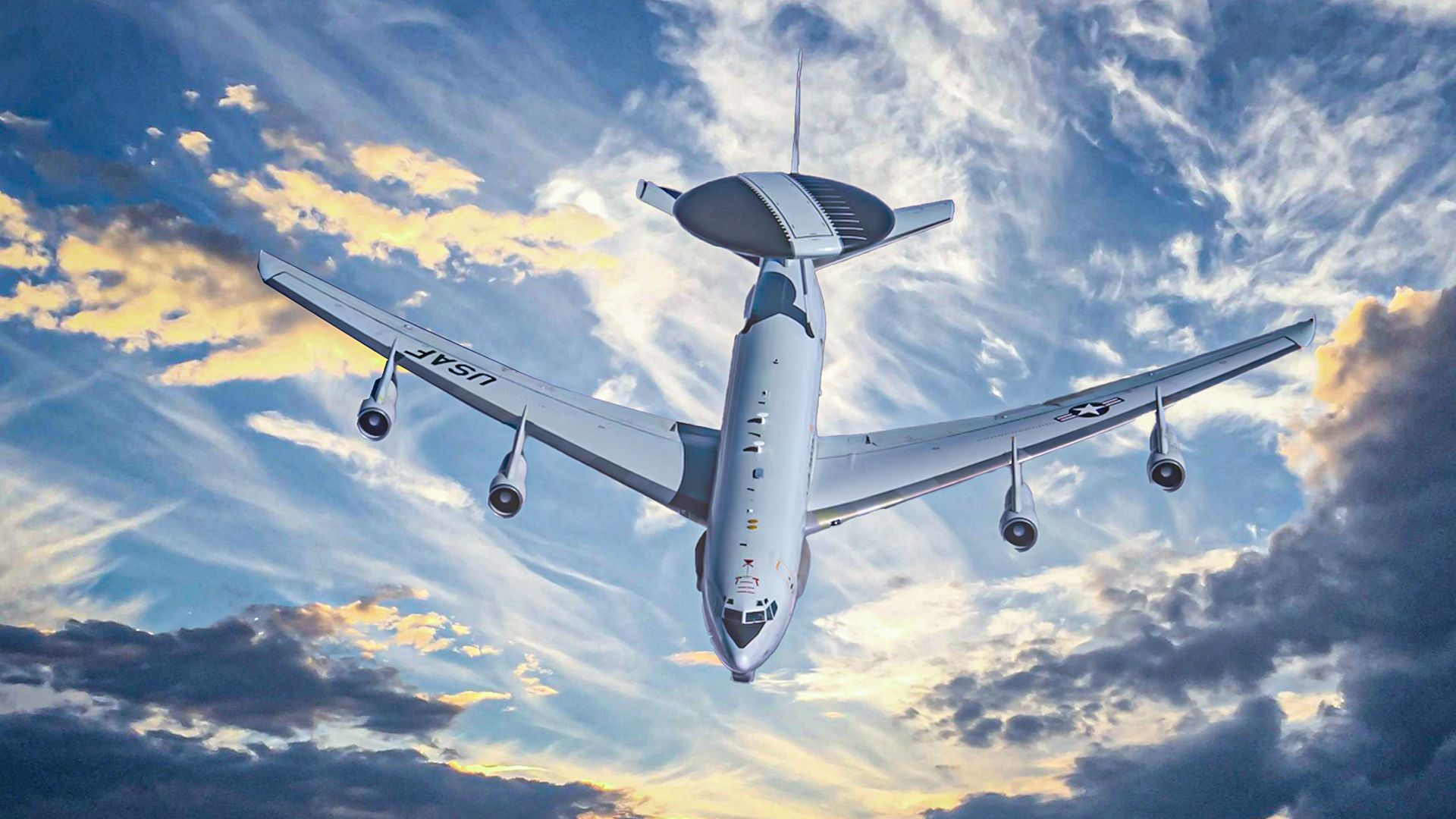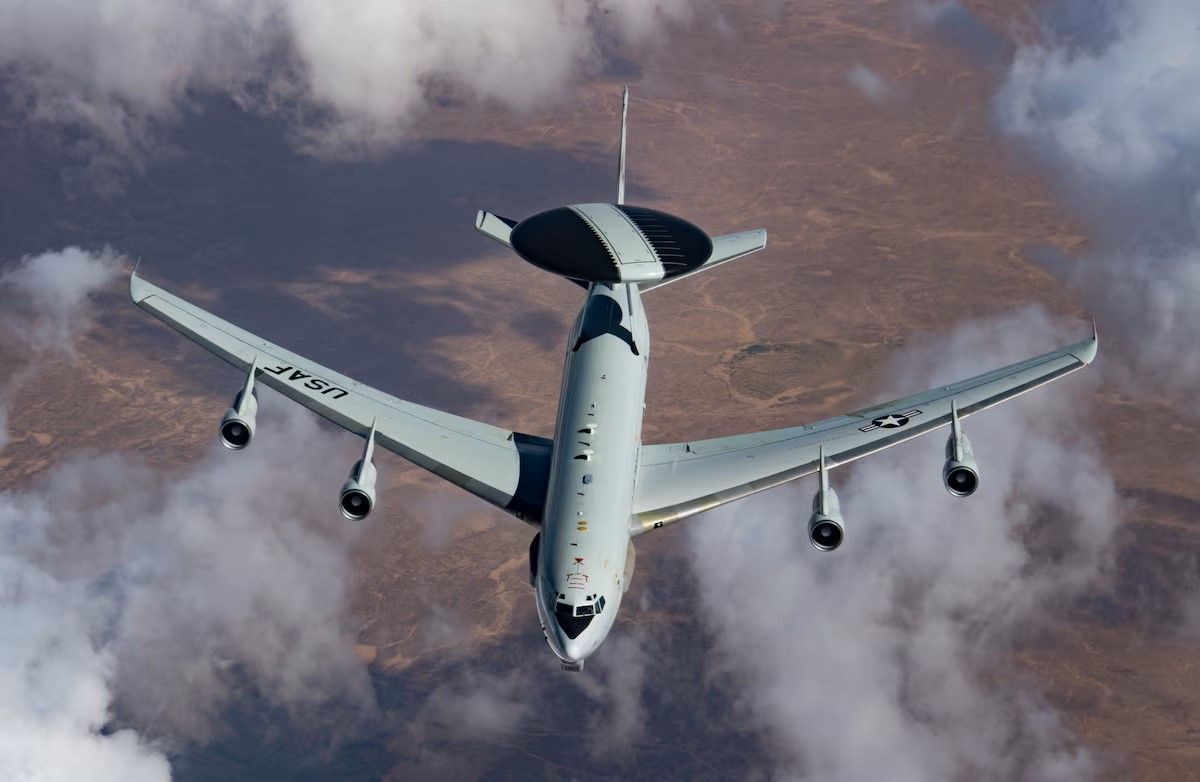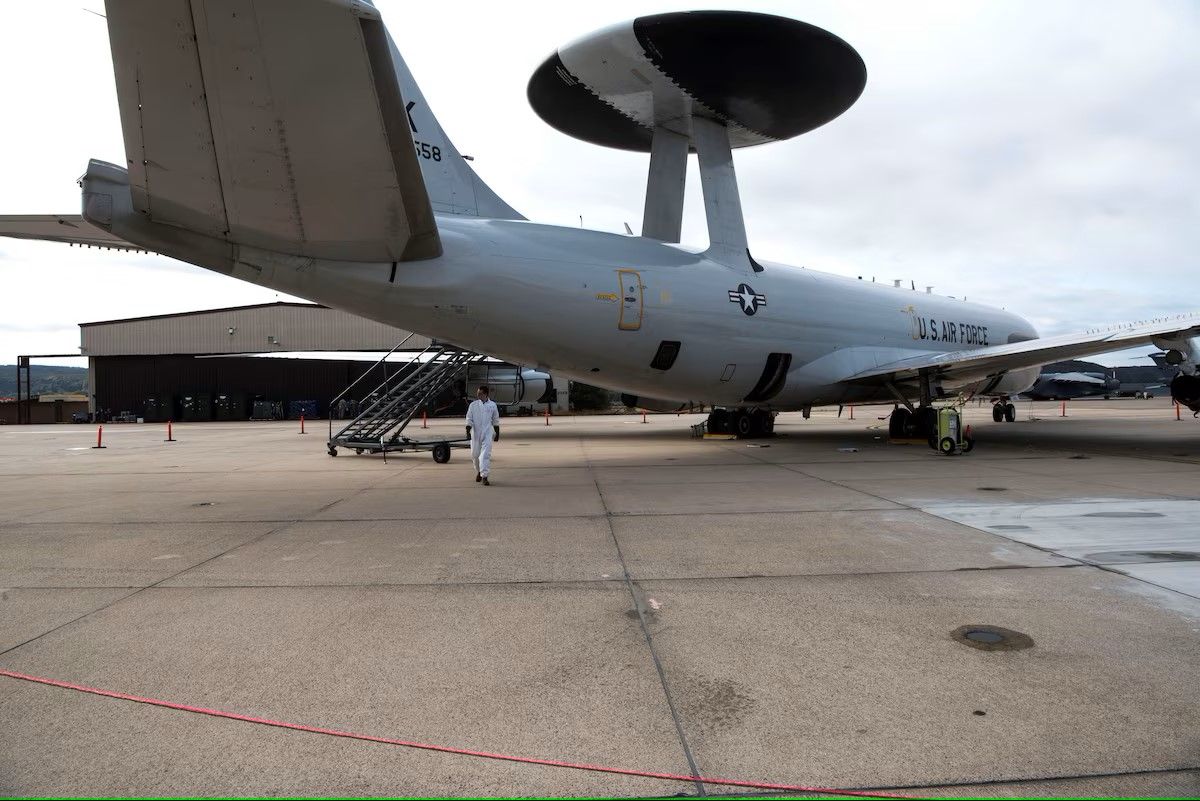Summary
- The E-3 Sentry AWACS is not retiring like JSTARS, staying strong as the USAF’s command-and-control platform.
- E-3 capabilities include high endurance, long-range surveillance, and support for air-to-ground and air-to-air operations.
- The E-3 Sentry’s powerful radar system and communication capabilities got a recent ESM update, aiding situational awareness.
One good Air Battle Manager (ABM) article deserves another. A month after doing a write-up on the E-8C Joint Surveillance Target Attack Radar System (JSTARS), which mainly deals with enemy ground vehicles (and low & slow flying enemy aircraft to some extent), now it’s time to cover JSTARS’s ABM comrade-in-arms, the E-3 Sentry Airborne Warning and Control System (AWACS) platform, which deals more with the aerial threats.
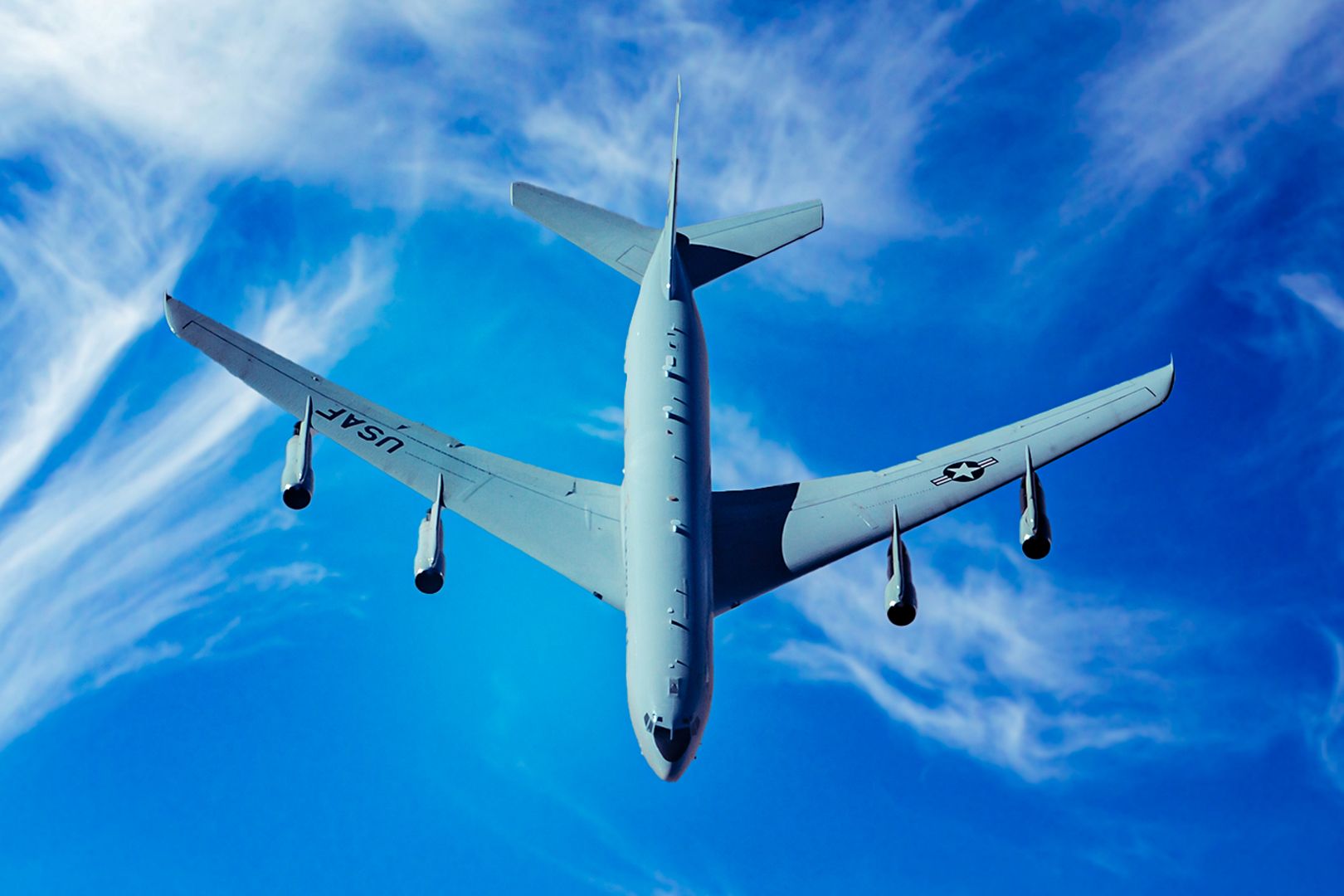
Related
The Ultimate Guide To E-8C JSTARS: Joint Surveillance Target Attack Radar System
JSTARS has been faithfully serving the US Air Force since 1991. So, what does the future hold for this remarkable plane & radar platform?
Both planes use a Boeing 707 airframe for their baseline platform. However, unlike JSTARS, which is being retired this year, AWACS shows no sign of going away anytime soon. Simple Flying now examines why AWACS is still going strong as the US Air Force’s (USAF’s) command-and-control platform.

Related
What Were The Differences Between The Boeing 707’s Main Variants?
Boeing continually improved its first jetliner, changing the course of aviation history in the process.
What is the mission of the E-3 AWACS?
Well, at the basic level, I suppose that’s partially self-explanatory based on what the acronym stands for. But the answer is a bit more complicated than that. For those more complex details, we turn to the ever-handy official U.S. Air Force Fact Sheets:
“The E-3 Sentry is an airborne warning and control system, or AWACS, aircraft with an integrated command and control battle management, or C2BM, surveillance, target detection, and tracking platform. The aircraft provides an accurate, real-time picture of the battlespace to the Joint Air Operations Center. AWACS provides situational awareness of friendly, neutral and hostile activity, command and control of an area of responsibility, battle management of theater forces, all-altitude and all-weather surveillance of the battle space, and early warning of enemy actions during joint, allied, and coalition operations.”
Clear as mud, right?
What are the capabilities of the E-3 Sentry AWACS?
In a word, impressive.
In a lot more words, we turn to another set of USAF Fact Sheets, one specific to Tinker AFB, Oklahoma (“Stinker Tinker,” as one of my old USAF buddies and mentors calls it), which is the most prominent home for American-owned E-3 Sentries, more specifically Air Combat Command’s (ACC) 552nd Air Control Wing (ACW) and Air Force Reserve Command’s (AFRC) 513th Air Control Group. To wit:
- Ability to conduct surveillance from the Earth’s surface up into the stratosphere, overland, or water
- Radar range of more than 250 miles (375.5 kilometers) for low-flying targets and further for aerial vehicles flying at medium to high altitudes
- An Identification Friend or Foe (IFF) radar subsystem that can look down to detect, identify, and track enemy and friendly low-flying aircraft by eliminating ground clutter returns that confuse other radar systems (such as traditional Doppler radar).
- Gather and present real-time, detailed battlespace information for position and tracking information on enemy aircraft and ships and the location and status of friendly aircraft and naval vessels.
- Though not specialized for air-to-ground operations to the same extent as JSTARS, AWACS can still provide significant support to these ops, providing direct information needed for interdiction, reconnaissance, airlift, and close-air support (CAS) for friendly ground forces.
- For its bread-and-butter air-to-air ops and ability to detect, identify, and track airborne enemy forces far from the boundaries of the United States or NATO countries. It can direct fighter-interceptor aircraft to these enemy targets, with detection abilities far beyond those of either friendly or enemy fighters.
- Impressive endurance: ability to fly a mission profile for more than eight hours without refueling.
What are the key features of the E-3 Sentry?
The centerpiece is, of course, the plane’s radar system, a rotating, spherical radar dome that is 30 feet (9.1 meters) in diameter, six feet (1.8 meters) thick, and is held 11 feet (3.33 meters) above the fuselage by two struts.
The plane also has long-range communication capabilities, thanks to a wide range of comm systems, including radios, data links, and satellite communications, to allow the crew to communicate with other aircraft and ground-based control centers. (As another of my former USAF colleagues liked to say, “No Comm, No Bomb!”).
More recently (circa April 2022), the E-3G variant received a significant update to its electronic support measures (ESM) database. A contemporaneous USAF press release quoted Maj. Jesse Snook, 605th Test and Evaluation Squadron (TES), Detachment 1, for details:
“While most airborne EW [electronic warfare] systems provide self-protection, the primary purpose of the E-3G’s ESM system is to provide situational awareness, combat identification, and threat warning for the rest of the assets in theater. Modern advanced radars are increasingly digital and can adapt faster than ever before, and the mission data update process needs to adapt along with it,”
“The E-3G has demonstrated its ability to exchange near real-time electronic warfare information with the experts on the ground and feed that information back into the fight immediately.”
In a nutshell, the Sentry collected EW information whilst in mid-flight over central Texas using its existing ESM system and transmitted the in-flight recorded data to the 36th Electronic Warfare Squadron (EWS) at Eglin AFB, Florida, using its satellite communications system. Less than an hour later, the 36th EWS processed and analyzed the E-3G’s data, corrected deficiencies observed in the data, and transmitted the updated file back to the Sentry for immediate loading during the mission. The in-air update and in-air flight data transmissions were firsts for the platform.
How does AWACS work?
Besides that incredibly powerful and farsighted radar, AWACS aircraft may also be equipped with other sensors, such as infrared (IR) and electro-optical cameras, to provide additional situational awareness. As for the radar itself, the aforementioned rotating dome allows it to scan the airspace in all directions; in other words, it’s a three-dimensional (3D) that measures azimuth, range, and elevation simultaneously. The comm system operates over a single channel, secure from enemy interception, that is also relatively immune to jamming because of its high speed.
Can AWACs direct missiles?
The system can definitely *detect* missiles, but as for *directing* them, as in guiding them? I’ve found no indicators from any authoritative sources, such as those Air Force Fact Sheets. The best source (relatively speaking) I’ve been able to find thus far is a 6-month-old Reddit discussion, but I’m unable to verify the professional bona fides of the posters making their claims. One respondent, username “Northstar_98,” claimed the following:
“At least some AEW&C aircraft (namely the E-2D Advanced Hawkeye) have co-operative engagement capability with the AIM-120D and likely future missiles.”
The Hawkeye, of course, is the US Navy’s AWACS platform. Assuming Northstar_98’s claims are true, the E-3 Sentry platform is conspicuous by its absence from his comment.
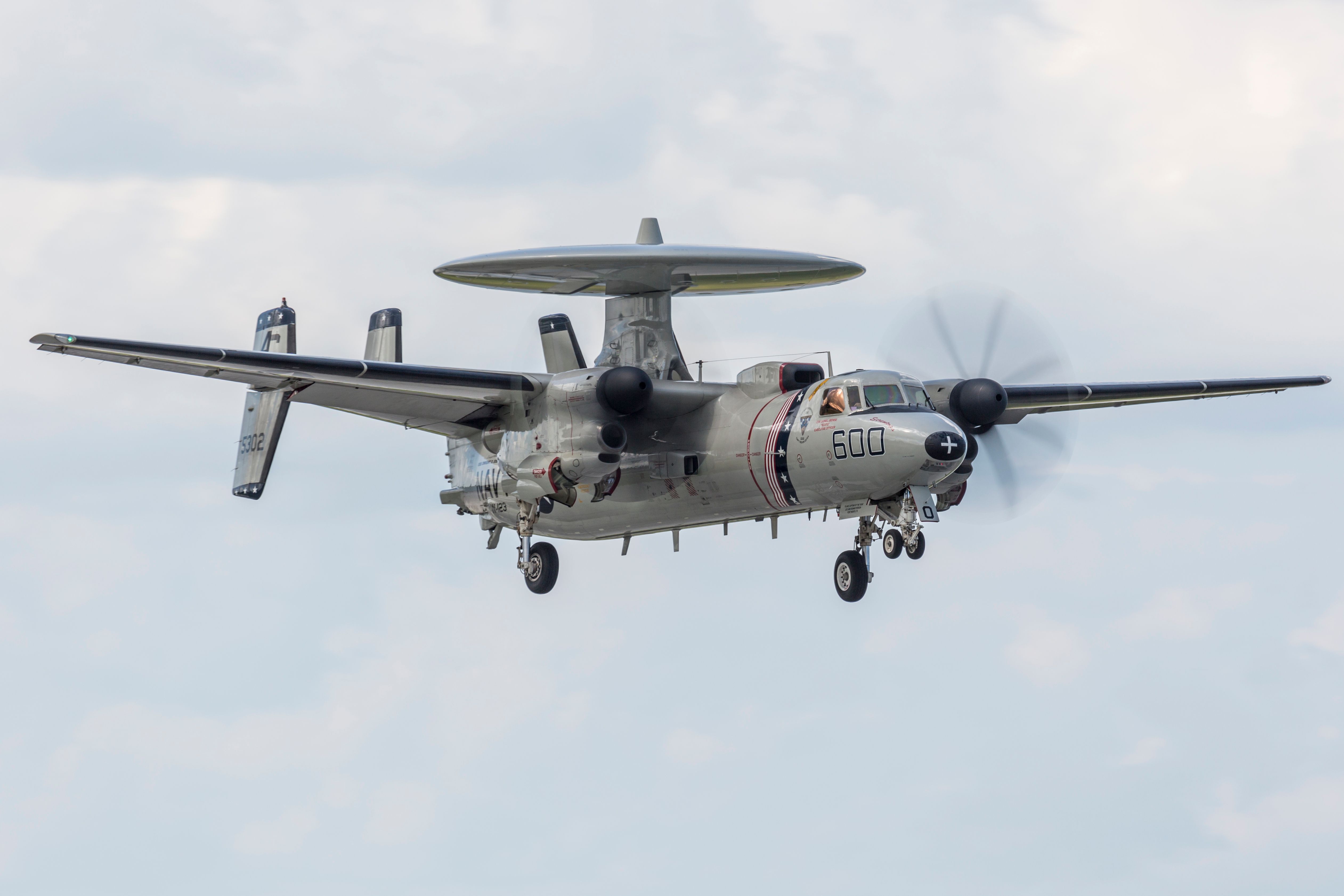
Related
Why Has The Northrop Grumman E-2 Hawkeye Had Such A Long Production Run
Over 60 years of development and updates
The AIM-120 is the Advanced Medium Range Air-to-Air Missile (AMRAAM), nicknamed the “Slammer,” which is an active radar-guided missile that provides true “fire-and-forget” capabilities.

